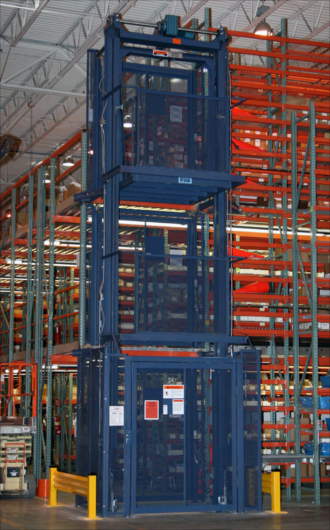
Series M Mechanical Vertical Lift
A PFlow Series M Mechanical Vertical Lift is the most versatile Vertical Reciprocating Conveyor. It is for multi-level applications at high-speed, for large or heavy loads that is versatile and dependable. Our Mechanical Vertical Lifts offers maximum flexibility with heavy-duty construction.

Series M Mechanical Vertical Lift
Heavy-Duty Series M Mechanical Vertical Lift
- Conforms to ASME B20.1 Safety Standards
- Lifts loads up to 10,000 lbs
- Carriage sizes up to 12′ x 12′ (or more)
- Vertical rise to 200 ft. (or more)
- Standard travel speed is 25-30 FPM (Up to 600 FPM)
- Series M Mechanical Vertical Lift offers High Performance and Durability with a Proven 2-Post Mechanical Design
- Designed to transport large, heavy loads between two or more levels. Ideal for high-cycle, automated systems or frequent use applications.
- Carriage is lifted and lowered by heavy-duty roller chain attached to a mechanical lifting mechanism.
- Built-in, advanced safety features protect workers and materials. Access gates at each level are interlocked with lift operation.
- Engineered to meet your exact application and height requirements.
- Straddle or cantilever carriages.
- Heavy-duty construction provides superior strength, reliability and long-term performance.
- Available with patented DeckLock system that provides additional security at critical upper levels.
- Indoor or outdoor use
Legacy Series M Information
 for “M Series” Mechanical Lifts
for “M Series” Mechanical Lifts
To enlarge video, Click the lower right ![]() icon.
icon.
Heavy-Duty Series M Mechanical Vertical Lift Specifications
GENERAL
Pflow Mechanical Vertical Conveyor Lift Series M Vertical Lifts move materials between two or more levels. Principal components are guide columns, carriage and a mechanical actuating mechanism.
APPLICATION DATA
Pflow Mechanical Vertical Conveyor Lift Series M Vertical Lifts are available with: Lifting capacities to 8,000 lbs.; carriage sizes to 10′ x 12′; vertical rise to 200′. Standard travel speed is 25-30 fpm. Travel speeds up to 400 fpm are available on special order.
STRUCTURE
Guide columns are 6″ wide flange sections. Carriage is fabricated of 4″ or 6″ structural members with steel deck plate. Other deck surfaces can be supplied. Carriage is available in straddle or cantilever styles depending on application.
OPERATION
Carriage is lifted and lowered by roller chain attached to an electric motor/reducer assembly mounted on the guide columns. Power units employ 2 HP to 10 HP TEFC brake motors. Special sensing and guidance systems monitor lift chains.
ELECTRICAL
Standard power requirements are 230V/460V, 3-phase. Control voltage is 110V. Control stations and remote mounted control panel are NEMA 12. Control stations, provided for each level, include self-maintaining push buttons with mushroom-head E-Stop button.
SAFETY FEATURES
Upward and downward travel of the carriage is limited by a limit switch. When switch is tripped or power is lost, the motor shuts off and the mechanically actuated brake is engaged. Overload protection is provided by a relay that measures the motor current. If the current exceeds the amount required to move the maximum load, it will shut the unit down and engage the brake. Safety cams, mounted on each guide column, prevent uncontrolled descent in case both chains break. Chain sensors shut down unit if chain tension is lost. Chain tensioners and guides prevent chains from jumping on sprockets. NO RIDER signs are posted at each point of operation. Available with optional DeckLock Safety System.
CARRIAGE SIDE GUARDS
Carriage is equipped with safety rails on non-operating sides and safety chains or diagonal drop bars on operating ends. Optional expanded metal or sheet metal carriage side guards are available.
SAFETY ENCLOSURES
Safety codes (ANSI/ASME B20.1) require gates and enclosures on all sides of the lift. Enclosures must be a minimum of 8′ high and reject a ball 2″ in diameter. Pflow manufactures gates and enclosures with 1/2″ expanded metal in a structural angle frame. Gates are accessible during loading/unloading and are electrically and mechanically interlocked with carriage movement. Interlocks prevent gates from being opened unless the carriage is at the designated level and also prevent carriage movement if any gates are not fully closed and locked.
